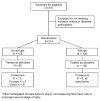A randomized trial of birthing with and without stirrups
- PMID: 22840725
- PMCID: PMC3409565
- DOI: 10.1016/j.ajog.2012.06.043
A randomized trial of birthing with and without stirrups
Abstract
Objective: The objective of the study was to determine whether bed delivery without stirrups reduces the incidence of perineal lacerations compared with delivery in stirrups.
Study design: In this randomized trial, we compared bed delivery without stirrups with delivery in stirrups in nulliparous women. The primary outcome was any perineal laceration (first through fourth degree).
Results: One hundred eight women were randomized to delivery without stirrups and 106 to stirrups. A total of 82 women randomized to no stirrups (76%) sustained perineal lacerations compared with 83 in women allocated to stirrups (78%) (P = .8). There was no significant difference in the severity of lacerations or in obstetric outcomes such as prolonged second stage of labor, forceps delivery, or cesarean birth. Similarly, infant outcomes were unaffected.
Conclusion: Our results do not incriminate stirrups as a cause of perineal lacerations. Alternatively, our findings of no difference in perineal lacerations suggest that delivering in bed without stirrups confers no advantages or disadvantages.
Copyright © 2012 Mosby, Inc. All rights reserved.
Conflict of interest statement
DISCLOSURE: The authors report no conflict of interest
Figures



References
-
- Hamilton BE, Martin JA, Ventura SJ. National vital statistics report. 3. Vol. 59. National Center for Health Statistics; 2010. Births: Preliminary data for 2009 [online] - PubMed
-
- Crawford LA, Quint EH, Pearl ML, DeLancey JOL. Incontinence following rupture of the anal sphincter during delivery. Obstet Gynecol. 1993;82:527–31. - PubMed
-
- Sultan AH, Kamm MA, Hudson CN, Thomas JM, Bartram CI. Anal-sphincter disruption during vaginal delivery. N Engl J Med. 1993;329:1905–11. - PubMed
-
- Handa VL, Danielsen BH, Gilbert WM. Obstetric anal sphincter lacerations. Obstet Gynecol. 2001;98(2):225–30. - PubMed
-
- Fenner DE, Genberg B, Brahma P, Marek L, DeLancey JO. Fecal and urinary incontinence after vaginal delivery with anal sphincter disruption in an obstetrics unit in the United States. Am J Obstet Gynecol. 2003;189:1543–50. - PubMed
Publication types
MeSH terms
Grants and funding
LinkOut - more resources
Full Text Sources
Medical

